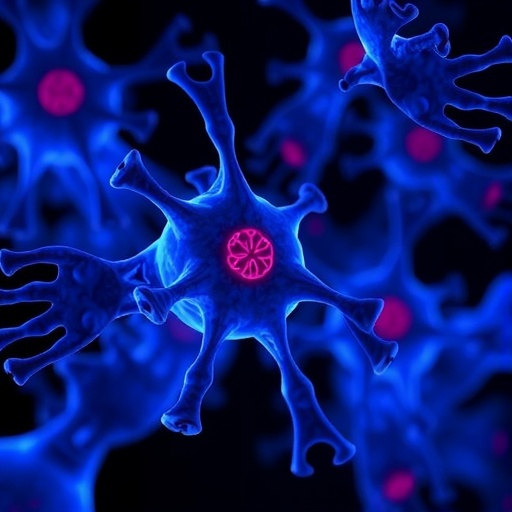In the ever-evolving landscape of cancer research, cell cycle regulators have emerged as pivotal players in tumor biology. A recent breakthrough study published in BMC Cancer introduces CDC6 (Cell Division Cycle 6) as a significant oncogenic driver with broad implications across multiple cancer types. This study transcends traditional boundaries, revealing CDC6’s multi-faceted roles not only in tumor proliferation but also in modulating the immune microenvironment, positioning it as a promising biomarker and therapeutic target.
CDC6 is fundamentally recognized as an essential factor in the initiation of DNA replication during the G1 and S phases of the cell cycle. Its canonical function involves licensing DNA replication origins, thereby ensuring the fidelity of DNA duplication. However, beyond this classical role, CDC6 is integral to the maintenance of the S-M checkpoint, a critical control mechanism that preserves genomic integrity by preventing premature mitotic entry. Disruptions in CDC6 expression have been implicated in genomic instability, a hallmark of cancer, which underpins its emerging role in tumorigenesis.
This comprehensive pan-cancer analysis leveraged an impressive array of multi-omics data sourced from high-quality repositories such as The Cancer Genome Atlas (TCGA), Genotype-Tissue Expression Project (GTEx), cBioPortal, and several others. By integrating genomic, transcriptomic, epigenetic, and proteomic datasets, researchers systematically evaluated CDC6’s expression patterns, mutational status, and epigenetic modifications across a spectrum of malignancies. This multi-dimensional bioinformatics approach allowed for unprecedented insights into CDC6’s oncogenic potential.
One of the groundbreaking findings from this study is the consistent overexpression of CDC6 across a wide range of tumor types when compared to normal tissue counterparts. This upregulation was not merely a passenger event but demonstrated strong associations with adverse clinical prognoses. Such robust correlations were evident in cancers of the lung, breast, colorectal, and notably, melanoma, suggesting that CDC6 could serve as a universal marker for tumor aggressiveness and patient outcomes.
Beyond expression, the investigation delved into the mutational landscape and epigenetic regulation influencing CDC6 activity. Intriguingly, alterations in DNA methylation patterns correlated substantially with shifts in CDC6 expression in nine different cancer types. These epigenetic modifications could provide a mechanistic explanation for the dysregulation of CDC6 and highlight potential avenues for targeted epigenetic therapy.
Equally compelling is the study’s exploration of CDC6’s interaction with the tumor immune microenvironment (TIME). CDC6 expression displayed significant correlation with immune cell infiltration patterns, implicating it in immunomodulation within tumors. These findings underscore CDC6’s dualistic role—not only driving cellular proliferation but also potentially shaping immune evasion or response mechanisms, positioning it as a candidate predictive biomarker for immunotherapy response.
To validate computational findings, the study incorporated functional assays focusing on melanoma, a notoriously aggressive and treatment-resistant skin cancer. Experimental overexpression of CDC6 in melanoma cells led to marked increases in proliferation, migration, and invasive capabilities. These in vitro results confirm CDC6’s critical role in enhancing malignancy and suggest that targeting CDC6 could restrain melanoma progression.
The implications of this research extend beyond biological understanding to clinical translation. Identifying CDC6 as a diagnostic and prognostic biomarker equips clinicians with a potential tool for early detection and risk stratification across several cancer types. Moreover, its influence on the immune microenvironment opens a novel frontier for combination therapies that integrate CDC6 inhibition with immunotherapeutic regimens.
This study also raises important questions about the molecular mechanisms through which CDC6 orchestrates these diverse roles. Does CDC6 interact directly with immune signaling pathways, or is its effect mediated through modulation of the tumor’s genetic and epigenetic landscape? Future studies focusing on the mechanistic underpinnings are necessary to harness CDC6’s full therapeutic potential.
From a therapeutic standpoint, targeting CDC6 could disrupt several oncogenic processes simultaneously—impairing cell cycle progression, restoring checkpoint control, and modulating immune responses. Small molecule inhibitors or RNA interference strategies aimed at CDC6 might provide a multi-pronged approach to combat tumors that rely heavily on its overexpression.
The study’s pan-cancer methodology strengthens the generalizability of findings, making CDC6 a prime candidate for broad-spectrum cancer therapies. Furthermore, its expression correlation with poor prognosis highlights its potential utility in personalized medicine frameworks where CDC6 expression levels could guide treatment choices and monitoring.
In the era of immuno-oncology, biomarkers that link cancer proliferation with immune landscape alterations are invaluable. CDC6 fits seamlessly into this paradigm, providing insights into tumor-immune dynamics and offering a biomarker that could refine patient stratification for immunotherapies. As immunotherapies continue to transform oncology, such dual-function biomarkers become increasingly critical.
Additionally, the observed epigenetic alterations associated with CDC6 hint at the plasticity of its regulation, making it amenable to epigenetic drugs. Combining epigenetic modifiers with conventional treatments could synergistically impede CDC6-driven tumor growth and address drug resistance, a major obstacle in current cancer therapy.
The collective evidence solidifies CDC6’s positioning at the crossroads of cell proliferation, genomic stability, and immune regulation. This convergence highlights the importance of integrative, multi-omics research approaches, as exemplified by this study, which unravel complex tumor biology enabling precision oncology advancements.
In summary, CDC6 emerges from this research not merely as a cell cycle participant but as a powerful oncogenic and immunological hub across diverse cancers. Its potential as a diagnostic beacon, prognostic indicator, and therapeutic target makes it a focal point for future cancer research. As scientists embark on elucidating CDC6’s mechanistic pathways, there is optimism that targeting this molecular linchpin could herald novel, more effective cancer interventions.
Subject of Research: Cell Division Cycle 6 (CDC6) as a pan-cancer biomarker for diagnosis, prognosis, and immunomodulation; its functional role in melanoma malignancy.
Article Title: CDC6 as a pan-cancer immunological and prognostic biomarker and its role in suppressing melanoma malignancy.
Article References:
Mo, L., Jia, M., Wu, Q. et al. CDC6 as a pan-cancer immunological and prognostic biomarker and its role in suppressing melanoma malignancy. BMC Cancer 25, 1426 (2025). https://doi.org/10.1186/s12885-025-14782-w
Image Credits: Scienmag.com
DOI: https://doi.org/10.1186/s12885-025-14782-w
Tags: CDC6 biomarker in cancerDNA replication initiation factorsgenomic instability and cancerimmune microenvironment in tumorsmelanoma tumor biologymulti-omics analysis in oncologyoncogenic drivers in cancerpan-cancer research findingsrole of cell cycle regulatorsS-M checkpoint maintenancetherapeutic targets for cancer treatmenttumor proliferation mechanisms





